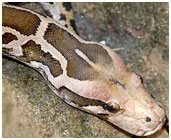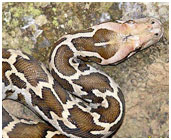Pythons are nom-venomous snakes, supposedly the largest in the world. For more information on Pythons, read the interesting and amazing facts given below.
Facts About Python
Not all snakes are poisonous and not all snake bites are fatal. There is a common misconception that the larger the snake is, the more severe the bite and hence a lot deadlier. Contrary to popular myth, Pythons are a lot more docile than other snakes its size and are believed to be harmless if left alone. Python is a genus of non-venomous snakes. The snakes are primarily found in Africa and Asia. There are a number of snakes that fall under the category of pythons, varying in physical, behavioral and habitation patterns. Usually, pythons attack their prey with surprise and suffocate them to death. The color of the snake also helps in this process, as pythons usually have their color matching their habitat and surroundings. Their slow and quiet movements are extremely cautious, not giving any opportunity to the prey to escape. Given below are some interesting and amazing information on pythons, just for your knowledge.

Fast Facts
Kingdom: Animalia
Phylum: Chordata
Subphylum: Vertebrata
Class: Reptilia
Order: Squamata
Suborder: Serpentes
Family: Pythonidae
Species: 7
Genus: Python
Length: 0.5 m - 10 m
Weight: Up to 40 Kg
Diet: Carnivorous
Natural Habitat: Africa, Asia
Average Age: 20 - 30 years
Age of Maturity: 2 - 8 years
Gestation Period: 3 - 4 months
Number of Eggs: 15 to 100 eggs (depending upon species)
Status: Endangered
Interesting & Amazing Information On Pythons
- Python is one of the world’s largest snakes, the other being anaconda.
- Pythons kill their prey by constriction, which means wrapping their own body around the body of the prey, several times. The prey dies of asphyxiation.
- Pythons eat wild animals, such as such as lizards, caiman, monkeys and antelope etc. When the heart of the prey stops, they swallow it whole.
- Except for the fur or feather, the entire animal is digested in the stomach of a python.
- The larger the meal, the longer a python takes to digest. It takes weeks and sometimes even months for a python to digest the ingested animal.
- A python usually eats only 4 to 5 times in a year.
- Pythons are usually not dangerous to humans.
- Pythons are ambush predators and attack the prey with surprise.
- The color of a python’s skin depends on the region it lives in.
- During the time of incubation, female pythons do not eat anything.
- Some of the species of the python family are very good swimmers. There are 30 different species of pythons that are believed to be the best swimmers.
- Pythons possess pelvic spurs, which are similar to back legs. These tiny bones are believed to have been a part of pythons, ever since its ancestors had them, which were chiefly large lizards.
- Pythons rely on the sun and their mood/behavior to regulate their body temperature.
- Certain species of pythons, such as the African Rock Python, are seen eating really large prey like a whole cow or an antelope.
- Common characteristics of an average python are overlapping scales, a distinct skin pattern, thin forked tongues, open eyes, and thickness of the body.
- The Green Tree Python is 7 feet in length and lives in the leaves of the high forest branches. It waits for the prey and strikes out as the birds fly by.
- A python typically lays 12 to 36 eggs at a time. Upon laying eggs, a python usually coils its body around the eggs, to keep them warm and protect them, until hatching.
- Pythons have the ability to camouflage themselves before catching their prey.
- One of the main reasons for killing a python is to obtain its beautiful skin, which is put to use for making clothing.
- Pythons move themselves by pushing against the ground with their scales. Usually, a python moves about a mile per hour on flat ground.
- The longest known snake is the Reticulated Python, reaching a length of about 30 feet!
- Reticulated Python is a nocturnal in nature and prefers to live a solitary life.
- Pythons are commonly found by water sides, swamps, tropical and sub-tropical regions.
- The Burmese Python is believed to be the most unique species of Pythons. They are yellow snakes with beautiful white patterns on them.
- Pythons can weight anything from 120-140 kgs.
- Most pythons have heat-sensing organs along their lower lip which enables them to detect hot objects in the surrounding environment with great accuracy.


See also
More from iloveindia.com
- Home Remedies | Ayurveda | Vastu | Yoga | Feng Shui | Tattoos | Fitness | Garden | Nutrition | Parenting | Bikes | Cars | Baby Care | Indian Weddings | Festivals | Party ideas | Horoscope 2015 | Pets | Finance | Figures of Speech | Hotels in India : Delhi | Hyderabad | Chennai | Mumbai | Kolkata | Bangalore | Ahmedabad | Jaipur
- Contact Us Careers Disclaimer Privacy Policy Advertise With Us Lifestyle Sitemap Copyright iloveindia.com. All Rights Reserved.




